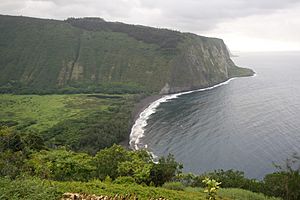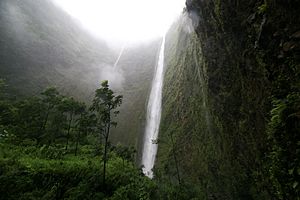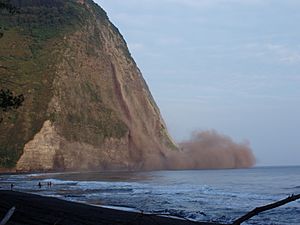Waipio Valley facts for kids
Waipiʻo Valley is a famous valley found in the Hamakua District. It is located on the Big Island of Hawaiʻi. The name "Waipiʻo" means "curved water" in the Hawaiian language. This name perfectly describes the winding river that flows through the valley.
Contents
A Look at Waipiʻo Valley's Past
Waipiʻo Valley was once a very important place. It was the main home and capital for many early Hawaiian leaders. These leaders were called Aliʻi, which means chiefs or kings. They lived here until the time of King ʻUmi.
This valley was also known for a special tree called the nioi tree. One famous nioi tree was known as "The burning Nioi of Paʻakalana." The valley was home to an ancient grass palace where the kings of Hawaiʻi lived. Sadly, in the 1700s, King Kahekili II of Maui attacked Waipiʻo. He burned down the four sacred nioi trees. The first chief to have his royal court in this valley was named Kahaimoelea.
Exploring the Valley's Landscape
The floor of Waipiʻo Valley is very low. It sits almost 610 meters (2,000 feet) below the land around it. A very steep road leads down into the valley. This road starts from a lookout point at the top of the valley's southern side.
The road drops 244 meters (800 feet) in just 1 kilometer (0.6 miles). Its average slope is 25%, but some parts are much steeper. Some sections of the road can be as steep as 45%. This makes Waipiʻo Valley Road one of the steepest roads in the world. It is the steepest road of its length in the United States. Only vehicles with four-wheel drive can use this paved public road.
The valley's shoreline has a beautiful black sand beach. This beach is a popular spot for surfers. You can also find a few taro farms in the valley. Taro is a plant grown for its starchy root. Many large waterfalls flow into the valley. These waterfalls feed the river that runs from the biggest falls at the back of the valley all the way to the ocean.
The Waimanu Trail
There is a walking path called the Waimanu or Muliwai Trail. This trail goes down a steep path to the Waimanu Valley. You can only reach Waimanu Valley by this trail or by boat. Hikers can use the trail, but they need a special permit from the state to camp in Waimanu. If you don't have a permit, you can still hike it as a very challenging day trip. At the top end of Waipiʻo Valley, the Waimanu Gap sits at 637 meters (2,089 feet) high. It leads to the southern part of Waimanu Valley.
Waipiʻo Valley in Movies
Waipiʻo Valley was used as a filming location. It was the setting for the final scene in the 1995 science fiction movie Waterworld. In the movie, the main characters finally find dry land in this valley.
Recent Access Changes
Waipiʻo Valley Road was closed to visitors for a while. It was closed from February 25, 2022, to September 19, 2022. This was done for safety reasons. Officials needed to check and fix problems with the road and the surrounding slopes. The closure meant that visitors could not enter the valley, whether by vehicle or on foot.
As of September 19, 2022, some access has returned. Residents of the Big Island can now enter the valley floor with a covered four-wheel-drive vehicle. Also, tour companies with county permits can go in. People who are practicing their Native Hawaiian traditional or customary rights can also access the valley.
In Hawaiian Folklore
Waipiʻo Valley plays a part in local Hawaiian stories and beliefs. According to Hawaiian folklore, the entrance to Lua-o-Milu (the Underworld) was hidden here. It was said to be covered by sand.




